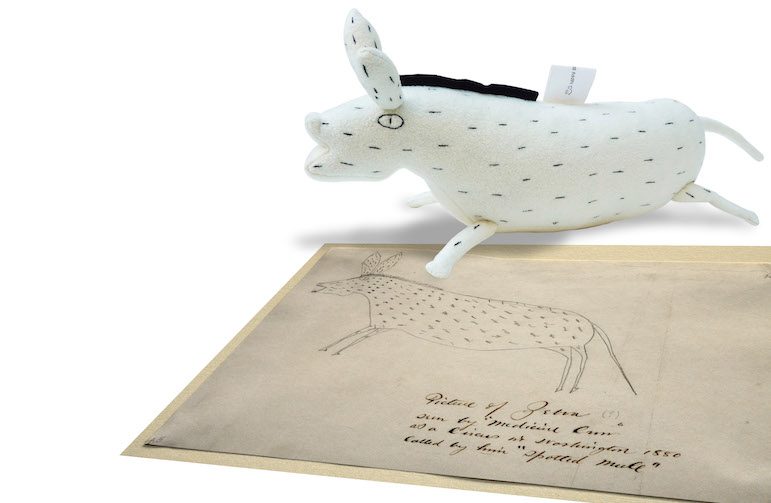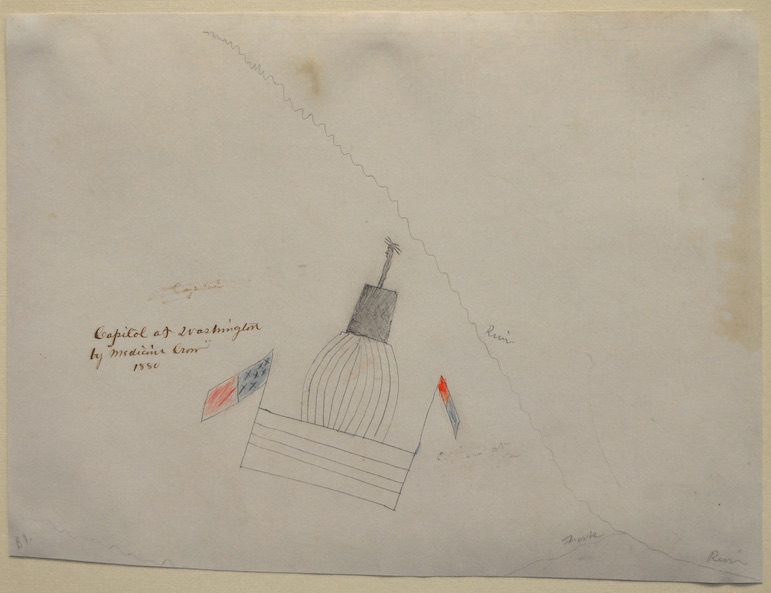An exhibition created by Crow artist Wendy Red Star, which opens next week in Billings, promises to be a powerful combination of art, artifacts, family and the reverberations of tribal history.
The exhibition, “Peelatchiwaaxpaash/Medicine Crow (Raven) and the 1880 Crow Peace Delegation,” will be in the Northcutt Steele Gallery at Montana State University Billings Oct. 20 through Dec. 1.
Over roughly the same period, the gallery and the MSU Billings Library will be sponsoring a free lecture series touching on Crow history, contemporary Indian art and traditional Crow music.
Red Star, who lives in Portland and has had a “fairly full” exhibition schedule in recent years, said she’s especially excited for the Billings show.
“This is the first time I get to come back home, into the town where I was born, and have the community come in and see my work,” she said.
She is also excited because the exhibition gave her a chance to collaborate with her daughter, Beatrice, now 9, and to collaborate in an odd and somewhat mystical way with Chief Medicine Crow, who died in 1920.
The many-layered exhibition will feature photographs of Medicine Crow and five other Crow leaders who traveled to Washington, D.C., in 1880 to meet with government officials. But these won’t include just the formal portraits that you may have seen before.

Photo courtesy of Wendy Red Star
As part of the exhibition, Red Star annotated copies of the photographs taken of the Crow delegation to Washington, D.C., including this portrait of Chief Medicine Crow.
Red Star made her own copies of the portraits and then annotated them in red ink, revealing details about the Crow leaders, their lives and the tribal and personal significance of their elaborate clothing and accouterments.
Other reproductions of the portraits were hand-colored by Beatrice, who was 7 at the time. Then there is the large star-quilt-style tapestry that Red Star created by turning other works of art based on those portraits into fabric swatches and stitching them together. The centerpiece of the quilt has two portraits of Medicine Crow, with Red Star’s face superimposed over the chief’s.
The exhibit will also include Medicine Crow’s original drawings of some of the things he saw in Washington, D.C., among them the U.S. Capitol building, trains, steamboats, gunboats on the Potomac River and the strange animals that he and the other Crow leaders saw for the first time at a circus.
Medicine Crow’s sketches are part of the Barstow Collection of ledger drawings, stored in the MSUB Library Special Collections and named for Charles H. Barstow, a Bureau of Indian Affairs clerk at Crow Agency in the late 1800s, who encouraged many Native Americans to fill ledger books with drawings and paintings.
Also on display will be some plush toys that Red Star commissioned and which are based on Medicine Crow’s drawings of circus animals. She did that as a way of encouraging children to get involved in the show, and partly as a way of commenting on all the ways the images of the Crow chiefs have been commercialized over the years.
The origins of the show go back almost two years, when MSUB art history professor Leanne Gilbertson was looking for a Crow artist to mount an exhibit in the Northcutt Steele Gallery, of which Gilbertson is also the director.
“I came across her work and was mesmerized by it,” Gilbertson said of Red Star. They communicated by phone and email, then finally met in the summer of 2015, when Red Star came back to Montana to attend Crow Fair. That’s when Gilbertson learned that Red Star had had an exhibit at the Portland Art Museum in 2014, built around images of and drawings by Medicine Crow.
The exhibition later traveled to the Figge Art Museum in Davenport, Iowa, and Humboldt State University in California, but this will be the first time it has included Medicine Crow’s actual drawings, rather than digital reproductions of them. Red Star herself has never seen the originals.Red Star, who is the niece of the widely known painter Kevin Red Star, said the idea for the original exhibition came to her because she so often encountered images of Medicine Crow, incorporated into works of art or used for commercial purposes, including, memorably, an ad for Honest Tea.
In all her years away from home, said Red Star, whose family is from Pryor and Lodge Grass, “The only time I saw another Crow person, pretty much, was when I went back to the reservation. Every time I saw Medicine Crow it made me so happy.”
It also occurred to her that nobody, apparently, had ever delved into what those photos meant, what other information they communicated. As she put it, “No one ever asked what happened when Medicine Crow sat down and got that photo taken.”

Wendy Red Star
So she started looking into his life. She found out that he was 36 at the time, and that he and other chiefs were in the capital for momentous negotiations regarding the size and composition of the Crow Indian Reservation. And then there was all the meaning to be extracted from what he was wearing and how, what he held in his hands and how he wore his hair.
That’s how she came up with the idea of annotating the portraits of all the chiefs. Although she is not directly related to Medicine Crow (whose grandson, Joe Medicine Crow, died in April at 102), she, like Medicine Crow, belongs to the Piegan clan, making him a clan father to her.
She said she also felt a close kinship to Chief Plenty Coups, another member of the 1880 delegation, because she operated Chief Plenty Coups State Park in Pryor in 2012-13. A mention of that went into her annotations of Plenty Coups’ photograph.
Red Star said she thought of having the plush toys made when she saw an advertisement aimed at parents, offering to make such toys based on their children’s drawings. She thought they would give children viewing the exhibition something to connect with. That was confirmed when she and Beatrice received the plush toys at their Portland home.
“When we opened up the package, she just sort of hugged them,” Red Star said. “That was pretty incredible to me.”
Beatrice’s further involvement in the show arose by accident. As Red Star was working to put the exhibit together—and knowing that she needed one more element to complete it—Beatrice asked her to play with her.
“It was crunch time, so I said to her, ‘Why don’t you take a stack of these’—handing her black-and-white copies of the Crow delegation photographs—‘and do what you want with them?’”
A little later, Beatrice wandered back with one of the Medicine Crow portraits, which she had colored in with crayons. Red Star she knew at once that here was the last thing the exhibit needed, “because it’s kind of up to the next generation … to own them and know the history.”
She set up a little studio for Beatrice and gave her 20 copies of the delegation photos “and she just sort of went to town.” And when the exhibit opened in Portland, Beatrice asked if she, along with her mother, could deliver some remarks.
“That’s when I learned she has a great talent for public speaking,” Red Star said, laughing at the recollection.

Photo courtesy of Wendy Red Star
The exhibition includes a portrait of Chief Medicine Crow, with Red Star’s face superimposed over his.
One result of having the exhibit at MSUB is that Red Star—and the rest of us, for that matter—now know more about those animals that Medicine Crow drew in the ledger books. Although Barstow’s annotations in the ledgers once mentioned a circus, elsewhere he said “zoo,” and it had always been assumed, and often repeated, that the animals Medicine Crow saw were in a zoo.
While helping to prepare a press release on the exhibition, Patrick Williams, a multimedia design specialist with MSUB’s University Relations and Communications, decided to look into the question. He found out that the National Zoo didn’t open in Washington until nine years after the Crow delegation’s visit.
And though there was a zoo in nearby Baltimore, in 1880 it consisted only of 52 deer and a flock of sheep, Williams said.
He started looking into circuses and discovered that the Ringling Bros., whose circus was not yet created, got their start by buying a circus and train from Adam Forepaugh, a real estate developer from Philadelphia whose circus in 1880 was considerably bigger than Barnum’s or Bailey’s (then separate operations).
A bit more research in the online newspaper archives at the Library of Congress turned up multiple front-page ads for the Forepaugh circus, which was in Washington “right in the middle of the delegation’s visit,” Williams said.
For further confirmation, he found a review of that circus when it appeared a few weeks later in Ohio, and there was a reference to a giraffe, and also a statement that it was the first giraffe ever seen in North America. That seemed to settle it, because one of Medicine Crow’s drawings was of a giraffe, which he called a “spotted mule,” the same name he assigned to a zebra.
That discovery, Red Star said, emphasizes the continuing nature of her exhibition, the idea that there is still so much to learn about members of the delegation and about tribal history. More than anything, she said, she wants people to know that Medicine Crow and the other delegates were the heroes of their people in a turbulent time.
“People did not realize that when he (Medicine Crow) sat down for that photo, he was fighting for Crow people’s rights, for the future of our reservation,” she said.
Lecture series
Here are the dates and other details on the lecture series being held in conjunction with Wendy Red Star’s exhibition. All lectures will be in Library Room 148, starting at 6:30 p.m.:
Tuesday, Oct. 18: C. Adrian Heidenreich, MSUB professor emeritus of Native American studies and anthropology: “The 1880 Crow Indian Delegation to Washington, D.C.: Cultural Identity, Colonial Policies, and Intercultural Images.” Opening reception to follow.
Tuesday, Oct. 25: John Lukavic, associate curator of Native Arts at Denver Art Museum: “From Contemporary to Traditional: Wendy Red Star and American Indian Contemporary Arts in Perspective.”
Thursday, Oct. 27: Wendy Red Star, multimedia and sculpture artist and enrolled member of the Crow: Artist talk.
Tuesday, Nov. 1: Elizabeth Guheen, director and chief curator of the Charles M. Bair Family Museum in Martinsdale: “Memory and Identity.” Rebecca West, curator of Plains Indian Cultures and the Plains Indian Museum at the Buffalo Bill Center of the West in Cody, Wyo.: “Behind the Scenes: Objects that Inspire Crow Indian Art.”
Tuesday, Nov. 15: Janine Pease, faculty member in the social sciences and humanities department at Little Big Horn College at Crow Agency, and Luella Brien, faculty member at St. Labre Indian School in Ashland: “A Conversation on Crow Identity and Resilience Through the Arts.”
Tuesday, Nov. 29: Desja Eagle Tail, recent MSUB graduate: “Native American Music: A journey in time though Native American Music with an emphasis on Crow traditional songs.” A musical presentation.
The Northcutt Steele Gallery will remain open until 8:30 p.m. on lecture series evenings. The exhibition and lecture series are being supported by Humanities Montana, with additional support from Northcutt Steele Gallery, MSUB Library, MSUB Foundation, MSUB Department of Art, and MSUB American Indian Outreach.







